Properties and Conditional Statements
Properties and Conditional Statements
Read/Write-Only Properties
Introduction
One of the goals of a property is to serve as a gateway between an object and its clients. One of the ways this gateway works is through the exchange of values between two objects. To keep this exchange in check, a property can be used to validate, then accept or reject the values that an object receives. A property can also be used to perform calculations on values received from client objects. To take of these and other situation, you can create one or more conditional statements in the body of a property.
![]() Practical Learning: Introducing Properties
Practical Learning: Introducing Properties
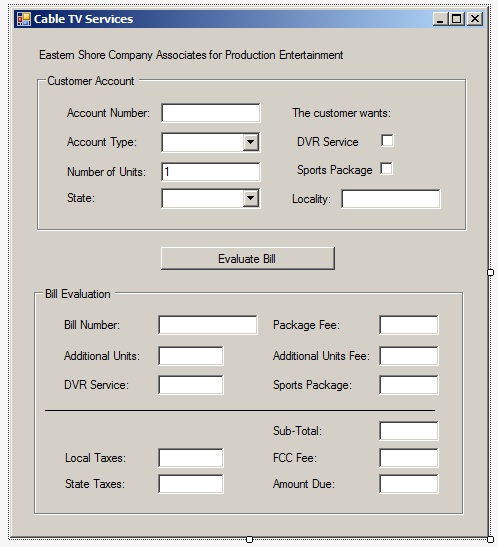
| Control | (Name) | Text | Other Properties |
| Label | Eastern Shore Company Associates for Production Entertainment | ||
| GroupBox | Customer Account | ||
| Label | Account Number: | ||
| TextBox | txtAccountNumber | ||
| Label | The customer wants: | ||
| Label | Account Type: | ||
| ComboBox | cbxAccountsTypes | Items:
Hospital Commercial Government Residential Senior Living |
|
| CheckBox | chkDVRService | DVR Service | CheckAlign: MiddleRight |
| Label | Number of Units: | ||
| TextBox | txtNumberOfUnits | 1 | TextAlign: Right |
| CheckBox | chkSportsPackage | Sports Package | CheckAlign: MiddleRight |
| Label | State: | ||
| ComboBox | cbxStates | Items:
Kansas Missouri |
|
| Label | Locality: | ||
| TextBox | txtLocality | TextAlign: Right | |
| Button | btnEvaluate | Evaluate Bill | |
| GroupBox | Bill Evaluation | ||
| Label | Bill Number: | ||
| TextBox | txtBillNumber | ||
| Label | Package Fee: | ||
| TextBox | txtPackageFee | TextAlign: Right | |
| Label | Additional Units: | ||
| TextBox | txtAdditionalUnits | TextAlign: Right | |
| Label | Additional Units Fee: | ||
| TextBox | txtAdditionalUnitsFee | TextAlign: Right | |
| Label | DVR Service: | ||
| TextBox | txtDVRService | TextAlign: Right | |
| Label | Sports Package: | ||
| TextBox | txtSportsPackage | TextAlign: Right | |
| Label | __________________ | ||
| Label | Sub-Total: | ||
| TextBox | txtSubTotal | TextAlign: Right | |
| Label | Local Taxes: | ||
| TextBox | txtLocalTaxes | TextAlign: Right | |
| Label | FCC Fee: | ||
| TextBox | txtFCCFee | TextAlign: Right | |
| Label | State Taxes: | ||
| TextBox | txtStateTaxes | TextAlign: Right | |
| Label | Amount Due: | ||
| TextBox | txtAmountDue | TextAlign: Right |
namespace ESCAPE3
{
public class Customer
{
public string AccountNumber { get; set; }
public string AccountType { set; get; }
public int NumberOfUnits { get; set; }
public bool DVRServiced { set; get; }
public bool RequestsSportsPackage { get; set; }
public string State { set; get; }
public string Locality { get; set; }
}
}A Conditional Statement in a Property Reader
A read-only property allows an object to provide values to other objects. Instead of just giving simple values, you can use such a property to perform meaning calculations that are based on some conditions. Any of the conditional statement we have studied so far can be used.
Besides simple conditional statements, we saw that you can create a local function in the body of a clause of a property.
![]() Practical Learning: Introducing Condition Statements in Properties
Practical Learning: Introducing Condition Statements in Properties
namespace ESCAPE3
{
public class CableBill
{
public CableBill()
{
Client = new Customer();
}
public int BillNumber { get; set; }
public Customer Client { get; set; }
public double PrimaryPackageFee
{
get
{
double pay = 0.00;
switch (Client.AccountType)
{
case "Senior Living":
pay = 9.65;
break;
case "Hospital":
pay = 12.55;
break;
case "Commercial":
pay = 24.35;
break;
case "Government":
pay = 21.25;
break;
case null:
pay = 16.95;
break;
}
return pay;
}
}
public int AdditionalUnits
{
get
{
int units = 0;
if (Client.NumberOfUnits > 1)
units = Client.NumberOfUnits - 1;
return units;
}
}
public double AdditionalUnitsFee
{
get
{
double additional = 0.00;
if (Client.NumberOfUnits > 1)
additional = 9.95 * Client.NumberOfUnits;
return PrimaryPackageFee + additional;
}
}
public double DVRFee
{
get
{
double fee = 0.00;
if (Client.DVRServiced == true)
fee = 6.65;
return fee;
}
}
public double SportsPackageFee
{
get
{
double fee = 0.00;
if (Client.RequestsSportsPackage == true)
fee = 8.85;
return fee;
}
}
public double SubTotal
{
get
{
return PrimaryPackageFee + AdditionalUnitsFee + DVRFee + SportsPackageFee;
}
}
public double FCCFee
{
get
{
return SubTotal * 0.00250881;
}
}
public double LocalTaxes
{
get
{
return (SubTotal + FCCFee) * 0.0372668;
}
}
public double StateTaxes
{
get
{
return (SubTotal + FCCFee) * 0.0082493;
}
}
public double AmountDue
{
get
{
return SubTotal + FCCFee + LocalTaxes + StateTaxes;
}
}
}
}using System;
using System.Windows.Forms;
namespace ESCAPE3
{
public partial class Form1 : Form
{
public Form1()
{
InitializeComponent();
}
Customer Identify()
{
return new Customer()
{
AccountNumber = txtAccountNumber.Text,
AccountType = cbxAccountsTypes.Text,
NumberOfUnits = int.Parse(txtNumberOfUnits.Text),
DVRServiced = chkDVRService.Checked,
RequestsSportsPackage = chkSportsPackage.Checked,
State = cbxStates.Text,
Locality = txtLocality.Text
};
}
private void btnEvaluate_Click(object sender, EventArgs e)
{
CableBill cb = new CableBill();
Random rndNumber = new Random();
cb.Client = Identify();
txtBillNumber.Text = rndNumber.Next(1, 1000000).ToString();
txtPackageFee.Text = cb.PrimaryPackageFee.ToString("F");
txtAdditionalUnits.Text = cb.AdditionalUnits.ToString("F");
txtAdditionalUnitsFee.Text = cb.AdditionalUnitsFee.ToString("F");
txtDVRService.Text = cb.DVRFee.ToString("F");
txtSportsPackage.Text = cb.SportsPackageFee.ToString("F");
txtSubTotal.Text = cb.SubTotal.ToString("F");
txtFCCFee.Text = cb.FCCFee.ToString("F");
txtLocalTaxes.Text = cb.LocalTaxes.ToString("F");
txtStateTaxes.Text = cb.StateTaxes.ToString("F");
txtAmountDue.Text = cb.AmountDue.ToString("F");
}
}
}
Account Number: 861402 Account Type: Commercial Number of Units: 6 State: Kansas Locality: Neighborhood
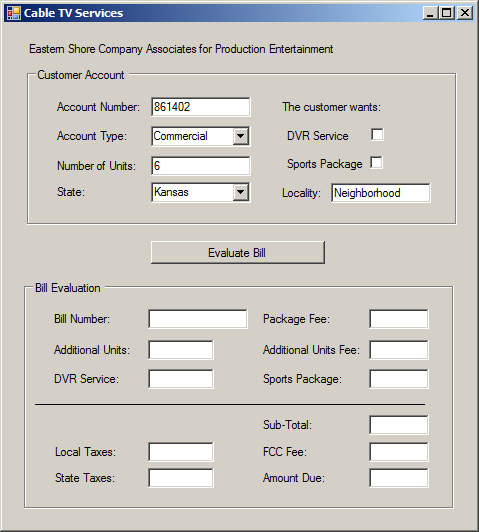
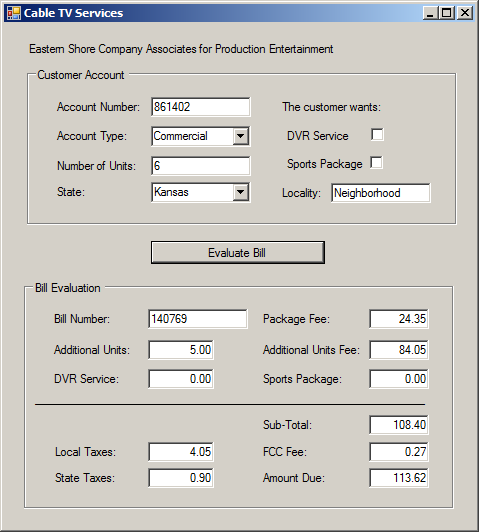
A Property with a Simple Return Statement
Most read-only properties contain a single line of code that returns their values. Such properties don't need a body delimited by curly brackets. For such a property, replace the opening curly bracket with the => operator, replace the get { return } expression with the statement to return, and omit the closing curly bracket.
![]() Practical Learning: Creating and Using Read-Only Properties
Practical Learning: Creating and Using Read-Only Properties
namespace ESCAPE3
{
public class CableBill
{
public CableBill() => Client = new Customer();
public int BillNumber { get; set; }
public Customer Client { get; set; }
public double PrimaryPackageFee
{
get
{
double pay = 0.00;
switch (Client.AccountType)
{
case string _ when Client.AccountType == "Senior Living":
pay = 9.65;
break;
case string _ when Client.AccountType == "Hospital":
pay = 14.25;
break;
case string _ when Client.AccountType == "Commercial":
pay = 24.35;
break;
case string _ when Client.AccountType == "Government":
pay = 21.25;
break;
case null:
pay = 18.95;
break;
}
return pay;
}
}
public int AdditionalUnits
{
get
{
if (Client.NumberOfUnits > 1)
return Client.NumberOfUnits - 1;
else
return 0;
}
}
public double AdditionalUnitsFee
{
get
{
if (Client.NumberOfUnits > 1)
return 12.95 * Client.NumberOfUnits;
else
return PrimaryPackageFee;
}
}
public double DVRFee
{
get
{
if (Client.DVRServiced == true)
return 6.85;
else
return 0.00;
}
}
public double SportsPackageFee
{
get
{
if (Client.RequestsSportsPackage == true)
return 8.95;
else
return 0.00;
}
}
public double SubTotal => PrimaryPackageFee + AdditionalUnitsFee + DVRFee + SportsPackageFee;
public double FCCFee => SubTotal * 0.00250881;
public double LocalTaxes => (SubTotal + FCCFee) * 0.0372668;
public double StateTaxes => (SubTotal + FCCFee) * 0.0082493;
public double AmountDue => SubTotal + FCCFee + LocalTaxes + StateTaxes;
}
}Account Number: 247947 Account Type: Residential Number of Units: 3 State: Missouri Sports Package: Checked Locality: Odessa
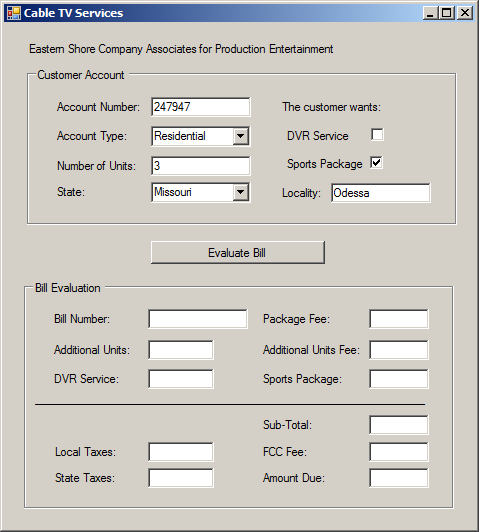
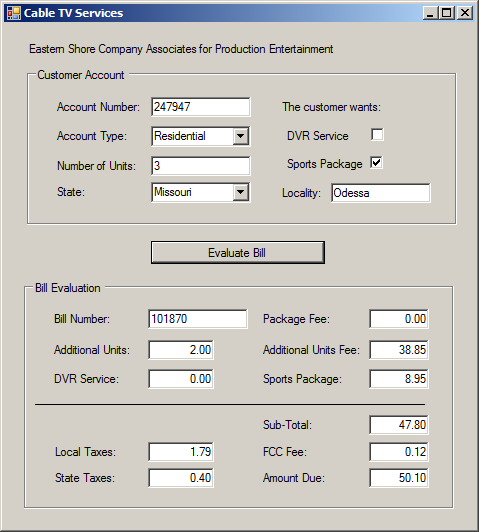
As you may remember, the ternary operator is used to simplify the code of an if...else conditional statement. You can use the ternary operator to create such a statement in property.
![]() Practical Learning: Using the Ternary Operator
Practical Learning: Using the Ternary Operator
namespace ESCAPE3
{
public class CableBill
{
public CableBill() => Client = new Customer();
public int BillNumber { get; set; }
public Customer Client { get; set; }
public double PrimaryPackageFee
{
get
{
double pay = 0.00;
switch (Client.AccountType)
{
case string _ when Client.AccountType == "Senior Living":
pay = 10.55;
break;
case string _ when Client.AccountType == "Hospital":
pay = 16.55;
break;
case string _ when Client.AccountType == "Commercial":
pay = 24.35;
break;
case string _ when Client.AccountType == "Government":
pay = 22.35;
break;
case null:
pay = 19.75;
break;
}
return pay;
}
}
public int AdditionalUnits
{
get
{
return (Client.NumberOfUnits > 1) ? Client.NumberOfUnits - 1 : 0;
}
}
public double AdditionalUnitsFee
{
get
{
return (Client.NumberOfUnits > 1) ?
12.95 * Client.NumberOfUnits :
PrimaryPackageFee;
}
}
public double DVRFee
{
get
{
return (Client.DVRServiced == true) ? 6.85 : 0.00;
}
}
public double SportsPackageFee
{
get
{
return (Client.RequestsSportsPackage == true) ? 8.95 : 0.00;
}
}
public double SubTotal => PrimaryPackageFee + AdditionalUnitsFee + DVRFee + SportsPackageFee;
public double FCCFee => SubTotal * 0.00250881;
public double LocalTaxes => (SubTotal + FCCFee) * 0.0372668;
public double StateTaxes => (SubTotal + FCCFee) * 0.0082493;
public double AmountDue => SubTotal + FCCFee + LocalTaxes + StateTaxes;
}
}Account Number: 537508 Account Type: Senior Living Number of Units: 58 State: Kansas DVR Service: Checked Locality: Holden
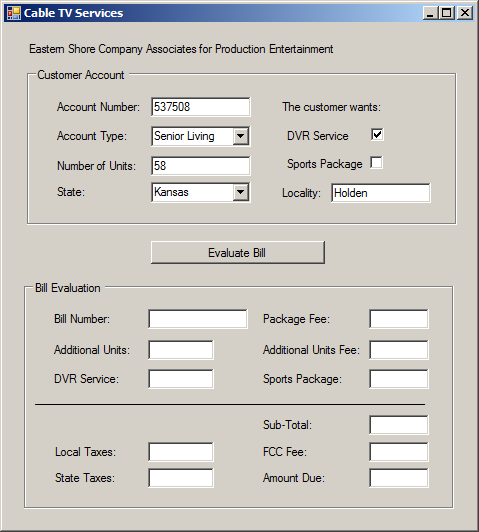
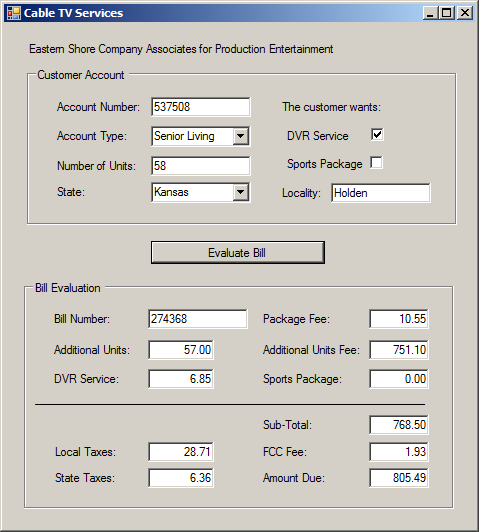
An Expession-Bodied Property
Another way to reduce the amount of code involved with a property os to create it as an expression-bodied member. In this case, replace the return keyword with the => operator.
![]() Practical Learning: Creating Expession-Bodied Properties
Practical Learning: Creating Expession-Bodied Properties
namespace ESCAPE3
{
public class CableBill
{
public CableBill() => Client = new Customer();
public int BillNumber { get; set; }
public Customer Client { get; set; }
public double PrimaryPackageFee
{
get
{
double pay = 0.00;
switch (Client.AccountType)
{
case string _ when Client.AccountType == "Senior Living":
pay = 10.55;
break;
case string _ when Client.AccountType == "Hospital":
pay = 16.55;
break;
case string _ when Client.AccountType == "Commercial":
pay = 24.35;
break;
case string _ when Client.AccountType == "Government":
pay = 22.35;
break;
case null:
pay = 19.75;
break;
}
return pay;
}
}
public int AdditionalUnits
{
get => (Client.NumberOfUnits > 1) ? Client.NumberOfUnits - 1 : 0;
}
public double AdditionalUnitsFee
{
get => (Client.NumberOfUnits > 1) ?
12.95 * Client.NumberOfUnits :
PrimaryPackageFee;
}
public double DVRFee
{
get => (Client.DVRServiced == true) ? 6.85 : 0.00;
}
public double SportsPackageFee
{
get => (Client.RequestsSportsPackage == true) ? 8.95 : 0.00;
}
public double SubTotal => PrimaryPackageFee + AdditionalUnitsFee + DVRFee + SportsPackageFee;
public double FCCFee => SubTotal * 0.00250881;
public double LocalTaxes => (SubTotal + FCCFee) * 0.0372668;
public double StateTaxes => (SubTotal + FCCFee) * 0.0082493;
public double AmountDue => SubTotal + FCCFee + LocalTaxes + StateTaxes;
}
}A Conditional Statement in a Property Writer
A property writer allows external objects to provide a value to its corresponding fields in the class. Because of this, and since it is through the writer that the external objects may change the value of the field, you can use the property writer to validate or reject a new value assigned to the field. Remember that the client objects of the class can only read the value of the field through the property reader. Therefore, there may be only little concern on that side. Here is an example:
public class TimeSheet
{
private double day;
public double Overtime
{
set
{
// A day contains only 24 hours. There is no way somebody can work over 24 hours.
if( day > 24 )
day = 0.00;
else
day = value;
}
}
}
Read/Write Properties
Introduction
Although most of your applications will use automatic properties, in many other applications, you will want to deciunder what circumtances and what values are allow to the objects of the class and what values should be refected. To take care of this, you can use either or both clauses of a property. Here is an example:
public class TimeSheet
{
private double day;
public double Overtime
{
get
{
if (day <= 8.00)
return 0.00;
else
return day - 8.00;
}
set
{
if( day > 24 )
day = 0.00;
else
day = value;
}
}
}
Simplifying the Code on Properties
To simplify the coe of a property, you can use the => operator on a simple clause. If your code is using a simple if...else conditional statement, you can simplify that code with a ternary operator.
![]() Practical Learning: Ending the Lesson
Practical Learning: Ending the Lesson
|
|
||
| Previous | Copyright © 2001-2021, FunctionX | Next |
|
|
||